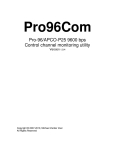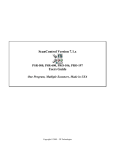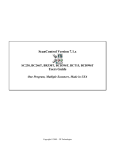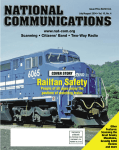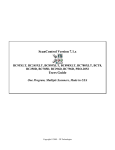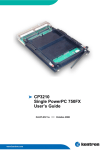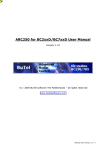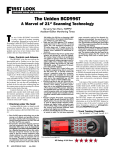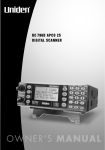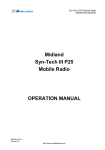Download Uniden BC250D System information
Transcript
Pro96Com Pro-96/APCO-P25 9600 baud Control channel monitoring utility Version 1.0 Copyright © 2004, Michael Vander Veer All Rights Reserved Table of Contents: Introduction: ....................................................................................................... 1 Acknowledgments: ............................................................................................ 1 Getting Started: .................................................................................................. 2 Screen Layouts: ................................................................................................. 3 Common Areas:.............................................................................................. 4 Screen Tabs:................................................................................................. 4 Tower Information Area:................................................................................ 5 Receive rates: ............................................................................................... 5 System Activity Screen:................................................................................. 6 Tower Activity:............................................................................................... 6 TalkGroup Hold: ............................................................................................ 6 Column Description:...................................................................................... 7 Affiliation Information Screen: ...................................................................... 8 Tower Affiliations Area: ................................................................................. 8 Affiliation Log Area: ....................................................................................... 8 Tower Information Screen: ............................................................................ 9 Tower Information: ........................................................................................ 9 Adjacent Tower Information: ......................................................................... 9 Frequency Identifier Tables:.......................................................................... 9 Patches Screen:............................................................................................ 10 Patch List: ................................................................................................... 10 Patch Log:................................................................................................... 10 Other Events Screen: ................................................................................... 11 Channel Grant Trace Screen: ...................................................................... 12 Unknown Packets Screen:........................................................................... 13 Packet Dump Screen:................................................................................... 14 Configuration Screen:.................................................................................. 15 Table of Contents: General Configuration Tab:......................................................................... 15 Communications:..................................................................................... 15 Latency:................................................................................................... 15 Auto Save Options:.................................................................................. 15 Screen and Column Sizes: ...................................................................... 15 Uniden Control Tab: .................................................................................... 16 Control Port: ............................................................................................ 16 Port Speed: ............................................................................................. 16 Scan Mode: ............................................................................................. 16 Quiet Frequency: ..................................................................................... 17 Private Call Priority: ................................................................................. 17 Logging Tab: ............................................................................................... 18 Affiliation Log Options:............................................................................. 18 Global Options:........................................................................................ 18 Fonts Tab:................................................................................................... 18 Use Global Font:...................................................................................... 18 TalkGroup Edit Screen:................................................................................ 19 Radio ID Edit Screen: ................................................................................... 20 Saving your data: ............................................................................................. 21 The Basics: ................................................................................................... 21 Files and formats:......................................................................................... 22 Configuring tables for UHF/VHF Systems in the Pro-96:.............................. 24 Introduction: Pro96Com is designed to decode the 9600 baud APCO-P25 control channel information using the Pro-96 scanner from Radio Shack and GRE. Data from the control channel is presented on various tabs on the screen. Pro96Com was made possible in part by GRE when they published the procedure for extracting this information from the Pro-96. It was also made possible with the release of the Pro96dmp program written by Rick Parrish. Rick has also answered a number of questions for me as they arose and his help is very much appreciated. Pro96Com is also capable of controlling a Uniden BC250D, BC296D, or BC796D scanner to monitor the system. While the program can control other models, these are the only ones that can currently monitor digital systems and thus are the only scanners supported in this release. Acknowledgments: I would like to thank the KQA414 group, Jim Sokol, and José E. Torres for their assistance on testing the various versions of this software while in development. I would also like to thank Rick Parrish for developing the Pro96Dmp program and answering my questions (and there were a lot of them early on). Note: Brand names mentioned in this document are trademarks of their respective companies. 1 Getting Started: To monitor a 9600 Baud APCO-P25 control channel with Pro96Com, you must have the following items: • • • • Pro-96 scanner Programming cable for the Pro-96 scanner Computer with at least one serial port (two serial ports if you intend to control a Uniden scanner). Computer with the Windows operating system. There are reports of the program not working properly on Windows ME systems due to differences in the serial ports. To place the Pro-96 into the proper mode to decode a 9600 Baud APCO-P25 control channel, follow these steps: 1. Tune the Pro-96 to the 9600 Baud APCO-P25 control channel you wish to monitor. 2. Press the PGM button 3. Press the FUNC button 4. Press the PGM button twice. At this point, the radio display should display the following: V-Scanner PC/IF Port Remote Acces CLR to EXIT 5. Run Pro96Com if not already running. 6. Click on the Data Read from Pro-96 button. At this point, the radio display should display the following: V-Scanner PC/IF Port ***IN USE*** CLR to EXIT Note: The ***IN USE*** line may alternate with Remote Access if the computer you are using is unable to keep up with the data stream. 2 Screen Layouts: When you start Pro96Com, you will see a screen that looks something like this: This is the main screen of the program. The following pages will go into detail about each screen that is available. 3 Common Areas: Screen Tabs: Information in Pro96Com is displayed on various screens in the program. These information screens are located on tabbed windows at the bottom of the screen. Available tabs are: System Activity: This tab displays the current activity on the tower being monitored. Affiliation Information: This tab displays information about radios that have affiliated with the current tower. Tower Information: This tab shows more information about the tower, including frequency tables, neighboring towers, and details about the tower itself. Patches: This tab shows any patches that are currently operating, and a log of patches that have been added or removed from the tower since the monitoring was started. Other Events: This optional screen will show events transmitted on the control channel that have no direct bearing on the other screens in Pro96Com. Channel Grant Trace: This optional screen will keep a running log of channel grants on the tower. Note that if you have a weak signal, this screen may not be accurate at all times. Unknown Packets: This optional tab shows any packets that Pro96Com does not yet know how to decode. Please consider sending any information found on this tab to the program author. Packet Dump This optional tab creates a running dump of the packets transmitted on the control channel. The output here is similar to the Pro96dmp program created by Rick Parrish. 4 Tower Information Area: Once you have begun decoding a control channel, the Tower Information area will display the System ID, Tower number (both decimal and hex format as shown on the Pro-96 display), the WACN ID, and the description of the system and the tower if they are available. If they are not available, you may use the system edit screen available in the System menu to edit this information. Receive rates: While monitoring a control channel, Pro96Com is constantly querying the radio for data. If new data is available, that information is placed in line in a buffer to be processed. The indicators in the lower left of the screen are intended to give you a reference to how well the control channel is being decoded. In the example shown, Pro96Com requested 50 packets from the radio and received 34 valid data packets to those requests. The machine is easily keeping up with the incoming data since the available buffer space is running at 100%. 5 System Activity Screen: Tower Activity: In the tower activity section, you will see a listing of the channels and frequencies used on the current tower. While a channel is active, you may double click on a channel to hold that TalkGroup. You may also right click on an active channel to edit the TalkGroup or radio id currently shown. TalkGroup Hold: To hold and monitor a single TalkGroup on a controlled Uniden scanner, click on the Hold TalkGroup button in the lower right corner of the System Activity screen. When you click on this button, a small dialog screen will appear similar to the one shown at the right. To hold on the displayed TalkGroup, click on the hold button. To hold on another TalkGroup, enter the TalkGroup number in the space provided and then click on the Hold button. You may also double click on a displayed Group call to hold that TalkGroup. 6 Column Description: Ch: This is the channel number being used by the system. The channel number is broken into two parts. The first part (before the dash (-) is the table ID. APCO-P25 systems may have up to 16 tables in use on the system labeled 0 through F (hex). The second part of the channel number is the channel within the specified table. More information on channel numbers can be found in the Tower Information screen section. Frequency The calculated actual frequency of the channel based on the information provided on the control channel. This frequency is calculated from the base frequency, spacing, and channel number provided in the frequency table. Usage This field shows how this frequency has been used by the system. See the section on usage flags following this section for more details. Type This lists how the channel is currently being used. If the channel is idle, this column will be blank. Possible entries in this field include Group (Standard Group Call), Private (Private call, AKA I-CALL), Phone (Telephone Interconnect). Priority When a channel is active, this column will list the priority value given to the TalkGroup. These priorities may be set using the TalkGroup editor. TalkGroup When a channel is active, this field will show the TalkGroup number that is active on this channel. If the channel is active with a private call, this will be the Radio ID of the person that initiated the private call. TalkGroup This is the description of the TalkGroup as entered by you. To edit Description the TalkGroup descriptions, you may right click on the entry while active on this screen, or select the System option on the menu and then choose the Edit TalkGroup option. Radio ID This is the radio ID of the current transmitting unit. This ID can be missed if you have a weak signal on the control channel as it is normally only transmitted once per transmission. Radio This is the user entered description of this radio. The first time Description Pro96Com sees a radio, it will add a default description that includes the TalkGroup number and date/time it was first seen. Active This column shows what TalkGroup you are currently monitoring if you are using the option to control a Uniden scanner. 7 Affiliation Information Screen: Before a radio may transmit on a trunked system, it must first notify the controller what tower and TalkGroup it needs. This process is known as affiliating with the tower. This screen lists all radios that have affiliated with the current tower since the program was started. The accuracy of this screen will improve as the program runs. Tower Affiliations Area: On the left side, all radios that have affiliated with the tower since the program was run are listed. To change the description of either the TalkGroup or the Radio, right click on the line you wish to change and select the ID you want to change. Then click the refresh button to reload the complete list with the new tags. Affiliation Log Area: The right side of the screen is a chronological listing of the affiliation activity on the tower since the program was started. You may optionally exclude denied affiliations from this log in the Configuration editor found under the Edit Menu. You may save the information in the affiliation log to a standard CSV format file. This file will be stored in the folder for this radio system. (See Saving your information later in this document for more information about the system folder) The AutoScroll checkbox will allow you to always keep the most recent affiliation activity on the screen at all times. Uncheck this box if you wish to browse the log. The Auto Save checkbox will automatically save new information to a log file every minute. This is the same as pressing the Save button manually every minute. This checkbox is not preserved across restarts. 8 Tower Information Screen: This screen shows the information being transmitted on the control channel about adjacent towers, and frequency tables. Tower Information: In the upper left corner, information about the current tower that is being transmitted by the control channel is displayed. Adjacent Tower Information: Frequency Identifier Tables: On the lower left side of the screen, any towers that are being advertised as being close to this tower are listed. SmartZone systems advertise this information so that radios that are moving away from this tower’s coverage area can quickly check for a better signal on one of these towers. Adjacent towers are also known as Neighbor sites. On the right side of the screen, any frequency identifier tables that are being broadcast from the tower are listed. ID 0 will almost always be as shown. These tables are used to calculate the correct frequency for the channel numbers that are transmitted on the control channel. Frequencies are derived from this information by multiplying the spacing by the channel number and adding that result to the base frequency. Information about calculating the values needed to make the Pro-96 properly track VHF and UHF Systems can be found near the end of this documentation. 9 Patches Screen: This screen will list any active patches. There is also a patch log that will show any patch activity that has occurred on this tower since the program was started. Patch List: The left side of the screen shows any active patches on the system. Patches will be shown in a format similar to that shown on the left. 2008 (D2South) Æ 2010 (D2West) This means that TalkGroup 2008 is patched to TalkGroup 2010. All transmissions on either 2008 or 2010 will appear on the system as 2010. Patch Log: The right side of the screen will be a running log of patch activity on this tower. As patches are added or removed from the tower, an entry will be placed in this window to that effect. This information may be saved to a standard CSV format file in the system folder. This file will be named Patches###.CSV where the ### is replaced by the tower number in a decimal format. If this file exists, the new data will be appended to the existing file. 10 Other Events Screen: This optional screen shows informational messages from the control channel. Most people will probably not have a need for this information. This screen includes the raw information from the control channel (Packet Data) and a description of what that data means. Since the majority of the entries on this screen tend to be unit registrations (Radios “logging on” to the radio system but not affiliating with a TalkGroup yet), there is an option to filter these packet types from this log. The items on this screen may also be saved to a file in the system directory. This information will be stored in the file named Events###.CSV where the ### is replaced with the tower number in decimal format. If the file exists, new data will be appended to that file. Checking the Auto Save option will save new information displayed on the screen to the file every minute. This is the same as pressing the Save button manually every minute. 11 Channel Grant Trace Screen: This is an optional screen that may be enabled in the configuration screen under the Edit menu. When a user presses the push-to-talk button on the radio, a signal is sent to the system controller with a request for an available repeater on the system. If a repeater is available, the controller will assign it to this radio and send a channel grant message for all radios that are using that TalkGroup. This message is called a channel grant message. This screen lists the date and time, what type of channel grant, the channel number, Frequency, TalkGroup, TalkGroup description, Radio ID and Radio description. This information is dependant on a good signal level to be accurate. The channel grant message is generally only transmitted once and can be easily missed on a weak signal. This information on this screen can be saved to CSV file in the system folder. The file will be named GrantLog-###.csv. As usual, the ### will be replaced with the tower number in decimal format. If the file already exists, new information will be appended to the existing file. As with the other screens, checking the Auto Save option will save new data on this screen to the log file every minute. 12 Unknown Packets Screen: This is an optional screen that may be enabled in the configuration screen under the Edit menu. This screen is primarily intended to help learn any packet formats that Pro96Com doesn’t currently know how to handle. If you enable this option and see packets listed in this screen, please save them to a file and forward them to the software author for analysis. This screen will list all unknown types of packets that may be transmitted over the control channel. You may save this information to a standard TXT format file in the system folder. This file will be named UnknownPackets-###.txt where the ### is replaced by the tower number of the current tower. The Auto Save option will save new data on this screen to the log file every minutes. 13 Packet Dump Screen: This is an optional screen that may be enabled in the configuration screen under the Edit menu. This screen will show the interpretation of each packet as it is decoded by Pro96Com. The output of this screen is similar in format to the pro96dmp program written by Rick Parrish. This screen is intended primarily as a debugging tool. It is not recommended that you leave this option turned on as it will use a lot of CPU and memory. Some people testing this feature have also reported crashing issues, presumed to be due to memory issues. Note: This screen will store up to 10,000 lines of data, after which the first lines of data will be deleted. This has the effect of appearing to auto scroll even if the auto scroll checkbox is not checked. You may save this information to a standard TXT format file in the system folder. This file will be named Dump-###.txt where the ### is replaced by the tower number of the current tower. The Auto Save option will save new data on this screen to the log file every minutes. 14 Configuration Screen: This screen may be accessed by selecting the Configuration option in the Edit Menu. Configuration options are available on the tabs shown. General Configuration Tab: This screen has all of the general configuration options for the basic operation of Pro96Com. Communications: In the Communications area, you may select the serial port number that will be connected to your Pro-96 scanner. The other communications parameters are hard coded in the program as they do not change. This option may not be changed while the program is reading data from the Pro-96. Latency: In the Latency area, you may change the amount of delay between attempts to query the Pro-96 for control channel data. The higher this option is set, the more delay between queries. Setting this option to 0 will remove all delays between requests, however it has been my experience that this will cause heavy use of the CPU and may slow down other applications on the computer considerably. Auto Save Options: In the Auto Save area, you may enable the Auto Save option. This option will save the data being collected at intervals you select between 1 minute and 60 minutes. These auto saves will only occur while Pro96Com is actively monitoring a tower. Screen and Column Sizes: Checking this option will have Pro96Com save all window sizes and positions in the INI file. These settings will then be reloaded on the next startup. This option will also save column sizes within each screen. 15 Uniden Control Tab: This tab allows you to enable control of a Uniden scanner. Since 9600 baud APCO-P25 systems are 100% digital, only the Uniden BC250D, BC296D, and the BC796D scanners with digital cards installed are supported. The program may control other Uniden scanners as well, but the value will be minimal at best. To enable control of a Uniden scanner, you will need to have a computer with at least two serial ports. One serial port will be connected to the Pro-96 to read the control channel data, the second serial port will be connected to the Uniden scanner to be used to monitor the voice transmissions. Control Port: This port is used to control the Uniden scanner. This port may not be set to the same port as the one being used to collect data from the Pro-96. Setting this port to the same port as the Pro-96 will automatically disable the Uniden control option. Port Speed: Uniden scanners may use a variety of port speeds. The scanner automatically detects the speed of the port based on the initial commands sent to it. If your Uniden scanner is having problems accepting control commands from Pro96Com, try changing the port speed to a lower speed until you get good results. Scan Mode: You may optionally have Pro96Com place the Uniden scanner in scan mode whenever there are no active TalkGroups on the system being monitored. 16 Quiet Frequency: The quiet frequency should be set to a frequency that is not used in your area. The Uniden scanner will be set to this frequency whenever there is no activity on the system being monitored, or when all active channels are set to a priority of Ignore. Private Call Priority: If you wish to monitor private calls, set the priority level you wish to use on these conversations. To disable private calls, set the priority level to Ignore. Individual TalkGroups may be set to any of 7 priority levels: Ignore Low Medium Low Normal Medium High High Extreme High Any TalkGroups with this level will be ignored and not monitored on the Uniden scanner. These TalkGroups would be those that you only want to hear if there is nothing else going on. More important than those low priority TalkGroups, but still not something that you want to listen to if something else is happening. This is the default level for new TalkGroups when detected by Pro96Com. More important than normal TalkGroups. Important TalkGroups you want to listen to before anything else Use this setting for those TalkGroups you want to hear no matter what else is happening. This might be a TalkGroup that broadcasts weather bulletins for example. 17 Logging Tab: This tab contains all settings relating to logging of data, and display of the optional screens. Each logging option may be set to automatically save the log on a per screen basis. When checked, the auto save option on that screen will be automatically checked when Pro96Com starts. Affiliation Log Options: In the Affiliation Log Options, you may choose to include or exclude denied affiliation requests in the affiliation log. Global Options: This checkbox will add the date to the beginning of the file name for all log files. This allows you to have a separate log file for each day if you wish. The date will be added as YYYYMMDDFonts Tab: This tab allows you to change the font settings for all screens, or for each individual screen. Use Global Font: When checked, one global font setting will be used for all screens. All individual screen font settings will be reset to the global settings. When not checked, you may individually set the fonts used on each screen independent of the other screens. 18 System Edit Screen: This screen allows you to edit the basic information about the current system and tower being modified. This screen may be accessed from the System menu. TalkGroup Edit Screen: This screen allows you to edit the text label and priority setting for a TalkGroup. This screen may be accessed from the System menu. To edit a TalkGroup, enter the TalkGroup number in the TalkGroup field and then move to the TalkGroup Name field. If a tag and priority are already associated with this TalkGroup number, the fields will be filled in with that information. You may also edit a TalkGroup by right clicking on an active entry on the system activity screen and selecting the edit TalkGroup option from that menu. This option is also available on the Affiliation screen. You may set the TalkGroup priority to any of the levels described in the previous section as desired. 19 Radio ID Edit Screen: This screen is similar to the TalkGroup edit screen. This screen may be accessed using the same methods as those listed for the TalkGroup edit screen. 20 Saving your data: The Basics: Pro96Com can save the data that is collected from a site for future reference. All information about a particular system is stored in the radio system folder. The system folder will be located in the folder where Pro96Com is located, and will be named System### where the ### is replaced by the hexadecimal system ID. As an example, we’ll use the Michigan Public Safety Communications System (MPSCS). The system ID for this system is 796. All files related to this system once saved may be found in the System796 folder located in the Pro96Com folder. To save your data, you must use the Save System Information option in the file menu. If you switch towers, you must save the information you have collected before starting the data collection on the new tower or all new information collected will be lost. 21 Files and formats: Pro96Com uses various files to store the information about the system. All files relating to a particular system will be stored in the system folder. File Name System.ini Description This file contains the basic information about the system including the system name, and the names of the individual towers that are a part of the system. Radios.txt This file contains a list of all of the radio ids that have been seen by Pro96Com. Information is stored in the file one radio per line. See the file for specifics on the format. TalkGroups.txt This file contains a list of all TalkGroup that have been seen by Pro96Com. All information about these TalkGroups is stored in this file including the text tag and monitor priority. See the file for more information about the format of this file. Tower####.txt These files will be created for each tower that has been monitored by Pro96Com. The #### in the file name will be replaced by the tower number of the specific tower in a decimal format. This file stores the frequency information for this tower, as well as the frequency tables and neighbor site information. Affiliations-###.csv These files will be created by pressing the save button on the Affiliation Log screen. The ### in the file name will be replaced by the tower number in decimal format. If this file already exists when the save button is pressed, any new information will be appended to the end of the file. 22 GrantLog-###.csv These files will be created by pressing the save button on the Grant Trace Log screen. The ### in the file name will be replaced by the tower number in decimal format. If this file already exists when the save button is pressed, any new information will be appended to the end of the file. UnknownPackets-###.txt These files will be created by pressing the save button on the Unknown Packets screen. The ### in the file name will be replaced by the tower number in decimal format. If this file already exists when the save button is pressed, any new information will be appended to the end of the file. EventLog-###.csv These files will be created by pressing the save button on the Other Events screen. The ### in the file name will be replaced by the tower number in decimal format. If this file already exists when the save button is pressed, any new information will be appended to the end of the file. Dump-###.txt These files will be created by pressing the save button on the Packet Dump screen. The ### in the file name will be replaced by the tower number in decimal format. If this file already exists when the save button is pressed, any new information will be appended to the end of the file. 23 Configuring tables for UHF/VHF Systems in the Pro-96: If you are monitoring APCO P25 systems that use the standard 800Mhz identifiers (Base of 851.00625Mhz, Spacing 0.00625) then there is no need to program in tables into the radio. If you are monitoring a system that uses different identifiers, you will need to use the multi-table option in the radio to properly track the system. APCO P-25 systems can have up to 16 identifiers. Each identifier contains the information needed by the radios on the system to calculate transmit and receive frequencies needed to communicate on the system. Identifiers are made up of a base frequency, channel spacing, transmit offset, and channel bandwidth. A typical identifier table for 800Mhz APCO P25 systems would look like the following: ID 0 Base Spacing TX Offset BandWidth 851.00625 0.00625 -45.00000 0.00625 On a Federal UHF system, a typical identifier table might look something like this: ID 0 2 Base Spacing TX Offset BandWidth 851.00625 0.00625 -45.00000 0.00625 406.00000 0.01250 10.00000 0.01250 On a VHF System, you may see something like this: ID 0 1 2 3 4 5 6 7 8 9 Base Spacing TX Offset BandWidth 851.00625 0.00625 -45.00000 0.00625 762.00000 0.00625 30.00000 0.00625 136.00000 0.01250 -5.00000 0.01250 136.00000 0.01250 -5.10000 0.01250 136.00000 0.01250 -5.20000 0.01250 136.00000 0.01250 -3.00000 0.01250 136.00000 0.01250 -4.50000 0.01250 136.00000 0.01250 3.25000 0.01250 136.00000 0.01250 3.00000 0.01250 136.00000 0.01250 4.50000 0.01250 These identifiers give you the information needed to make the Pro-96 properly track and monitor these systems. The Pro-96 has only 6 available table slots where the radio systems could use up to 16 identifiers. The key is to have Pro96Com monitor the specific towers you wish to monitor, and make a note of which identifiers are in use on those particular towers. You would then calculate the values needed for the tables. 24 For each identifier in use on the tower to be monitored, you can calculate the values needed by using the following formulas: Base: CH Lo: CH Hi: Offset: Step: Use the base frequency listed in the identifier. Identifier number * 4096 CH Lo + 4095 Same as CH Lo Spacing value shown in the Identifier The table below lists all of the calculated channel numbers needed for the Pro-96 tables for each identifier. Identifier CH Lo Ch Hi Offset 0 0 4095 0 1 4096 8191 4096 2 8192 12287 8192 3 12288 16383 12288 4 16384 20479 16384 5 20480 24575 20480 6 24576 28671 24576 7 28672 32677 28672 8 32678 36863 32678 9 36864 40959 36864 A 40960 45055 40960 B 45056 49151 45056 C 49152 53247 49152 D 53248 57343 53248 E 57344 61439 57344 F 61440 65535 61440 25 Example 1 (UHF): ID 2 Base Spacing TX Offset BandWidth 406.00000 0.01250 10.00000 0.01250 Base: 406.00000 CH Lo: Identifier * 4096 2 * 4096 8192 CH Hi: CH Lo + 4095 8192 + 4095 12287 Offset: 8192 (Same as CH Lo) Step: 12.5Khz Example 2 (VHF): ID 3 4 Base Spacing TX Offset BandWidth 136.00000 0.01250 -5.10000 0.01250 136.00000 0.01250 -5.20000 0.01250 Base: 136.00000 CH Lo: Identifier * 4096 3 * 4096 8192 CH Hi: CH Lo + 4095 8192 + 4095 12287 Offset: 8192 (Same as CH Lo) Step: 12.5Khz 26





























